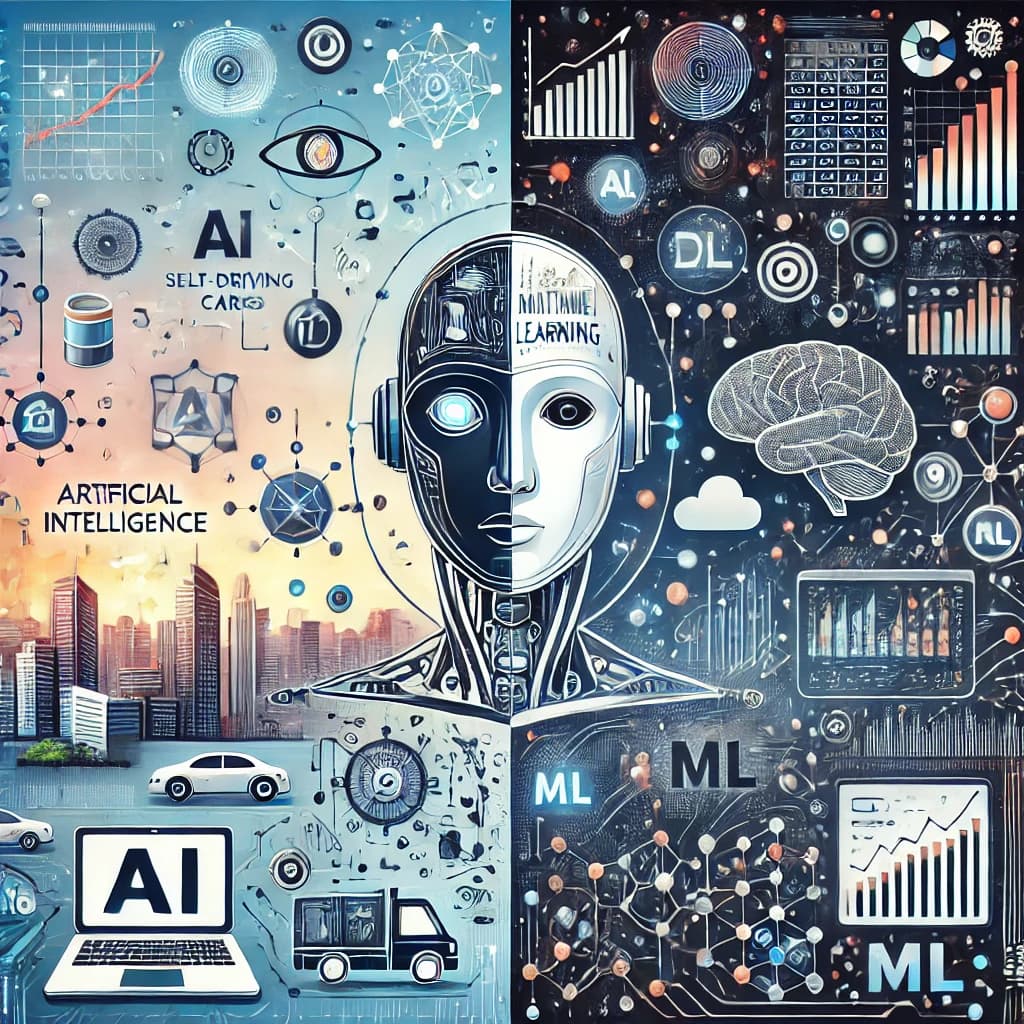AI vs ML: Understanding the Difference
Hello, curious minds! Today, we’re diving deep into the fascinating worlds of Artificial Intelligence (AI) and Machine Learning (ML). These two terms often get mixed up, but they’re not the same. Let’s explore what sets them apart and why understanding the difference is crucial in today’s tech-driven world.
The Big Picture: What is Artificial Intelligence?
Artificial Intelligence is the overarching concept of machines mimicking human intelligence. It’s about creating systems that can perform tasks requiring human-like decision-making, problem-solving, and understanding. Imagine a robot that can navigate a room, hold a conversation, or even beat you at chess—those are examples of AI in action.
Think of AI as the umbrella term that encompasses everything related to making machines smart. It’s the vision of building machines capable of reasoning, learning, and adapting just like humans.
Zooming In: What is Machine Learning?
Machine Learning is a subset of AI, focusing on the idea that machines can learn from data. Instead of explicitly programming a system to perform a task, you provide it with data, and it figures out how to perform that task on its own. The more data it has, the better it gets.
For instance, ever noticed how your email automatically filters out spam? That’s ML working behind the scenes, learning from vast amounts of data about what spam typically looks like.
Key Differences Between AI and ML
| Aspect | Artificial Intelligence (AI) | Machine Learning (ML) |
|---|---|---|
| Definition | Broad concept of machines performing human-like tasks. | A method to enable AI by learning from data. |
| Focus | Overall intelligence and decision-making. | Improving performance on a specific task. |
| Examples | Smart assistants, self-driving cars, robotics. | Recommendation systems, fraud detection. |
| Dependency | Can exist without ML (rule-based AI systems). | Requires AI concepts to operate. |
How Do They Work Together?
Although different, AI and ML often work hand-in-hand. For example, a self-driving car (AI) uses ML to recognize pedestrians, traffic lights, and other cars. The AI system sets the high-level goals—like safely navigating to a destination—while ML focuses on learning from real-world driving data to improve the car's ability to make split-second decisions.
Real-World Applications
1. Healthcare
AI is revolutionizing healthcare by improving diagnostics and treatment plans. ML models analyze patient data to predict diseases like cancer or heart conditions early. AI-driven robotic surgeons can assist in complex surgeries, enhancing precision and reducing human error.
2. Finance
In finance, AI helps detect fraudulent transactions in real time. ML models analyze transaction patterns to identify anomalies, protecting your hard-earned money. Meanwhile, AI systems assist with stock market predictions and personalized investment advice.
3. Entertainment
Ever wondered how Netflix seems to know exactly what you want to watch? That’s ML analyzing your viewing habits and making tailored recommendations. Similarly, AI powers immersive video game experiences, creating smarter and more challenging opponents.
4. Retail
AI chatbots provide 24/7 customer support, enhancing user experience. ML models optimize inventory management, ensuring products are always available when you need them.
The Evolution of AI and ML
The journey of AI and ML began decades ago, but recent advances have propelled them into the mainstream. Here’s a brief timeline:
- 1950s-1960s: The term "Artificial Intelligence" was coined, and early AI programs played games and solved basic problems.
- 1980s: Introduction of Machine Learning algorithms like decision trees and neural networks.
- 2000s-Present: The rise of deep learning, a more advanced form of ML, has driven breakthroughs in natural language processing, image recognition, and more.
Challenges and Ethical Considerations
While AI and ML offer incredible benefits, they also come with challenges:
1. Bias in Data
ML models are only as good as the data they’re trained on. If the data contains biases, the model will replicate them, leading to unfair outcomes.
2. Privacy Concerns
AI systems often rely on vast amounts of personal data. Balancing innovation with privacy is a significant challenge.
3. Job Displacement
As AI automates tasks, some jobs may become obsolete. However, it also creates new opportunities in tech and data science.
How to Get Started with AI and ML
If this discussion has piqued your interest, here’s how you can dive deeper:
- Learn the Basics: Start with beginner-friendly courses on platforms like Coursera or Khan Academy.
- Experiment: Tools like TensorFlow and PyTorch make it easy to build your ML models.
- Stay Updated: Follow blogs, podcasts, and news to keep up with the latest advancements.
Final Thoughts
AI and ML are not just buzzwords—they’re transforming the world around us. Understanding their differences and how they work together opens up exciting opportunities, whether you’re a tech enthusiast, a professional, or simply curious about the future.
So, what’s next? Start exploring, ask questions, and dive into this fascinating world. Who knows, you might just create the next groundbreaking AI system!
